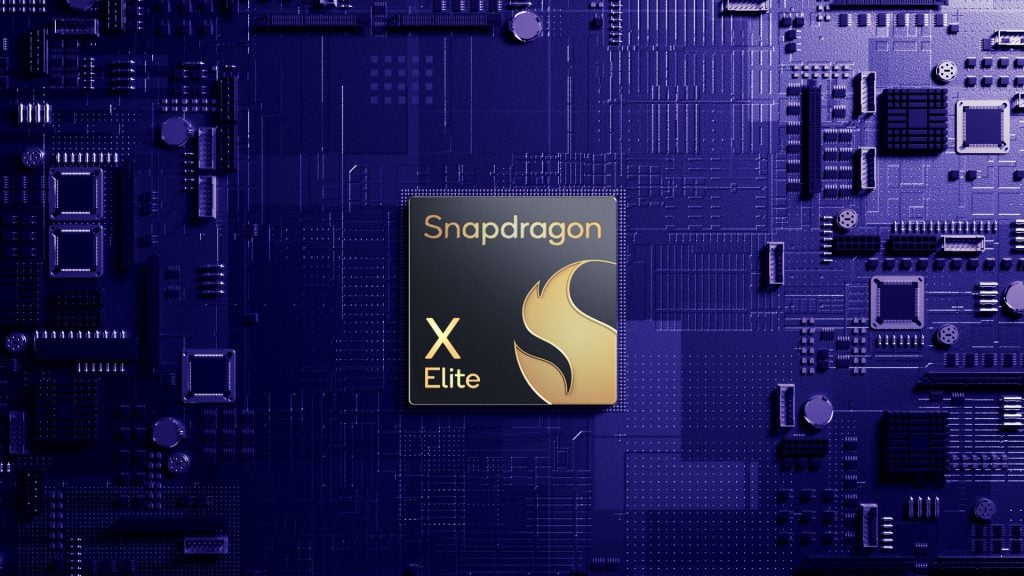Qualcomm unveiled its next-gen Windows on ARM platform, the Snapdragon X series CPU with bold claims on performance and efficiency. Essentially, Qualcomm aims to replicate the success of Apple’s M-series chip by providing a strong alternative for Windows on ARM laptops.
The Snapdragon X family includes two tiers: the high-performance Snapdragon X Elite and the more affordable Snapdragon X Plus. In this article, we’ll break down the details of these SoCs to make it easier for you to grasp.
1. Snapdragon X Elite
The X Elite is a multi-faceted chip, consisting of a central processing unit (CPU), an integrated graphics processing unit (GPU), and a Neural Processing Unit (NPU) all working in concert. The integrated design offers several advantages, including streamlined performance and improved power management.

The platform comes in three variants: the X1E-84-100, X1E-80-100, and X1E-78-100. The flagship X1E-84-100 is the top-of-the-line model with a 12-core Qualcomm Oryon CPU built on a 4nm process, capable of reaching speeds of up to 3.8GHz, with a single and dual-core boost mode pushing it further to 4.2GHz.
The Qualcomm Adreno GPU handles graphics processing. It delivers up to 4.6 TFLOPS of performance and supports DirectX12, making it well-suited for running modern Windows games. This GPU performance rivals the Xbox Series S (4 TFLOPS) but falls short of the current-gen Series X (over 12 TFLOPS).
The standout feature for AI enthusiasts is the Qualcomm Hexagon NPU which has an impressive impressive 45 TOPS for on-device AI acceleration. It dwarfs the current offerings from Intel and AMD, placing the X Elite at the forefront of AI processing for laptops. When combined with other components, the total theoretical AI performance reaches a staggering 75 TOPS.
Here’s a table summarizing the key specifications of the flagship X Elite (X1E-84-100):
| Feature | Specification |
| CPU | Qualcomm Oryon CPU, 64-bit architecture, 12 cores up to 3.8 GHz |
| GPU | Qualcomm Adreno GPU up to 4.6 TFLOPS, supports DX12 |
| NPU | Qualcomm Hexagon NPU, 45 TOPs |
| Memory | LPDDR5x, 8533 MT/s transfer rate, up to 64GB |
| Storage | SD v3.0, NVME over PCIe Gen 4, UFS 4.0 |
| Process | 4nm |
| Display | Qualcomm Adreno DPU, up to UHD 120Hz with HDR10 |
| Connectivity | Snapdragon X65 5G Modem up to 10 Gbps, up to Wi-Fi 7, with Bluetooth LE 5.4 |
The X1E-80-100 and X1E-78-100 variants retain the 12 cores, 42MB cache, and 45 TOPS NPU, but with slightly lower clock speeds (3.4GHz) and reduced GPU capabilities (3.8 TFLOPS). However, they still offer exceptional performance and cater to users who may not require the absolute top-end power of the X1E-84-100.
Beyond raw processing power, the X Elite platform boasts several other strengths:
- Extensive Connectivity: The Snapdragon X65 5G modem delivers blazing-fast internet speeds with peak downloads of 10Gbps, perfect for seamless cloud gaming and content downloads. Additionally, Wi-Fi 7 and Bluetooth LE 5.4 connectivity ensure smooth wireless interactions.
- Multi-Display Support: Users can connect up to three displays simultaneously at 4K resolution with a 60Hz refresh rate, ideal for multitasking and creating expansive workspaces.
- Advanced Security: Qualcomm emphasizes “enterprise-grade” security within the X Elite platform, crucial for protecting sensitive data.
- Next-Gen Multimedia: AV1 encoding and decoding enable stunning 4K HDR video experiences. Additionally, Snapdragon Sound Tech Suite ensures lossless audio quality for an immersive entertainment experience.
- On-Device Generative AI: The X Elite boasts 30 tokens per second for on-device generative AI, which could revolutionize creative workflows in the future.
These features, combined with the raw processing power, position the Snapdragon X Elite as a formidable contender in the laptop SoC market.
2. The Snapdragon X Plus
The Snapdragon X Plus (X1P-64-100) caters to a more budget-conscious market. While sharing many similarities with the X Elite, it features a 10-core Oryon CPU with a maximum clock speed of 3.4GHz.
It retains the powerful Adreno GPU with 3.8 TFLOPS and the impressive 45 TOPS NPU. The key difference lies in the number of CPU cores, with the X Plus offering two fewer cores compared to the X Elite’s base variant.

The reduction in cores translates to a slight decrease in multi-threaded performance. However, Qualcomm claims the X Plus still delivers 10% faster multi-threaded performance than the Apple M3 and 37% faster performance than the Intel Core Ultra 7 155H, all while consuming significantly less power.
The X Plus offers similar features as the X Elite, including LPDDR5x RAM support, NVMe storage over PCIe Gen 4, UFS 4.0 storage, 5G and Wi-Fi 7 connectivity, USB4 connectivity, and AV1 encoding and decoding for 4K HDR video. It also supports dual cameras of up to 36 megapixels, a single camera of up to 64 megapixels, and 4K HDR video capture.
Here’s a closer look at the Snapdragon X Plus (X1P-64-100) specifications:
| Feature | Specification |
| CPU | Qualcomm Oryon CPU, 10 cores (up to 3.4 GHz) |
| GPU | Qualcomm Adreno GPU (up to 3.8 TFLOPS, DirectX 12 support) |
| NPU | Qualcomm Hexagon NPU (45 TOPS) |
| Memory | LPDDR5x RAM (up to 64GB) |
| Storage | SD v3.0, NVMe over PCIe Gen 4, UFS 4.0 |
| Display | Up to UHD 120Hz with HDR10 |
| Connectivity | Snapdragon X65 5G Modem (up to 10 Gbps), Wi-Fi 7, Bluetooth LE 5.4 |
3. The Future of Windows on Arm
The debut of the Snapdragon X platform is a significant development for Windows on Arm laptops. With offerings such as the X Elite and the budget-friendly X Plus, Qualcomm is offering compelling options for manufacturers and consumers alike.
Whether it can emulate Apple’s triumph with the M-series chips remains uncertain. Nonetheless, the X Series has the features and performance to make it a strong contender to the likes of Apple, Intel and AMD.
Related:
- Qualcomm officially announced its Snapdragon X Plus chip with world’s fastest NPU for laptops
- Qualcomm’s performance claims about Snapdragon X Elite turned out to be misleading
- Snapdragon 7 Gen 3 vs Snapdragon 7+ Gen 2: Which Processor is Right for You?
- MediaTek Dimensity 7050 vs. Snapdragon 6 Gen 1: Which Processor is Right for You?
- Xiaomi 13 Ultra Premium Camera Phone is now only $799
- Get $100 OFF on Xiaomi 14 Pro at Giztop (1TB Variant)
- Lenovo Legion Y700 2024: Latest Gaming Tablet with Enhanced Display now available at Giztop
- WhatsApp Last Seen Not Updating? Here’s How to Fix It







